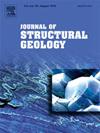Seismogenesis in the brittle–plastic transition zone of the Yecheon shear zone, South Korea
IF 2.9
2区 地球科学
Q2 GEOSCIENCES, MULTIDISCIPLINARY
引用次数: 0
Abstract
This study investigates seismogenesis in the brittle–plastic transition zone of the Yecheon Shear Zone, South Korea. The NE-to NNE-striking right-lateral shear zone cuts a Mesozoic granitoid pluton in an outcrop that was investigated in this study. We focus on light green layers within granite mylonitic rocks that preserve evidence of seismic slip events and subsequent plastic deformation. Field observations and microstructural analysis reveal a complex history of brittle and plastic deformations. The light green layers, formed by frictional melting during seismic events, contain injection structures, flow textures, and euhedral to subhedral microlites with inclusions. Elevated pore-fluid pressure might have played a crucial role in initiating seismic ruptures in the brittle–plastic transition zone, forming shear band ruptures or R shear planes and implosion breccia in the releasing stepovers in shear band ruptures. We propose a seismogenic model involving fluid pressure buildup, formation of shear band ruptures, rupture propagation into the C foliation, and the formation and subsequent alteration of pseudotachylytes. The fine-grained nature of the altered pseudotachylytes would have promoted strain localization during interseismic periods, leading to their transformation into ultramylonite. These findings improve our understanding of earthquake nucleation processes in the brittle–plastic transition zone and highlight the importance of fluids in inducing seismic events.
韩国玉川剪切带脆性-塑性过渡带的地震成因
本文研究了韩国伊川剪切带的脆性-塑性过渡带的地震成因。北东向北北东向的右侧剪切带在露头中切割了一个中生代花岗岩类岩体。我们专注于花岗岩糜糜岩中的浅绿色层,这些层保存了地震滑动事件和随后的塑性变形的证据。现场观察和微观结构分析揭示了脆性和塑性变形的复杂历史。浅绿色层是由地震活动中摩擦熔融形成的,包含注入结构、流动结构和自面体至亚面体微岩及其包裹体。孔隙流体压力的升高可能对脆性-塑性过渡带地震破裂的启动、剪切带破裂或R剪切面的形成以及剪切带破裂释放台阶的内爆角砾岩的形成起了至关重要的作用。我们提出了一个孕震模型,包括流体压力积聚,剪切带破裂的形成,破裂扩展到C片理,以及伪岩的形成和随后的蚀变。蚀变伪岩的细粒性可能促进了震间期应变局部化,导致其转变为超长晶石。这些发现提高了我们对脆性-塑性过渡带地震成核过程的认识,并突出了流体在诱发地震事件中的重要性。
本文章由计算机程序翻译,如有差异,请以英文原文为准。
求助全文
约1分钟内获得全文
求助全文
来源期刊

Journal of Structural Geology
地学-地球科学综合
CiteScore
6.00
自引率
19.40%
发文量
192
审稿时长
15.7 weeks
期刊介绍:
The Journal of Structural Geology publishes process-oriented investigations about structural geology using appropriate combinations of analog and digital field data, seismic reflection data, satellite-derived data, geometric analysis, kinematic analysis, laboratory experiments, computer visualizations, and analogue or numerical modelling on all scales. Contributions are encouraged to draw perspectives from rheology, rock mechanics, geophysics,metamorphism, sedimentology, petroleum geology, economic geology, geodynamics, planetary geology, tectonics and neotectonics to provide a more powerful understanding of deformation processes and systems. Given the visual nature of the discipline, supplementary materials that portray the data and analysis in 3-D or quasi 3-D manners, including the use of videos, and/or graphical abstracts can significantly strengthen the impact of contributions.
 求助内容:
求助内容: 应助结果提醒方式:
应助结果提醒方式:


